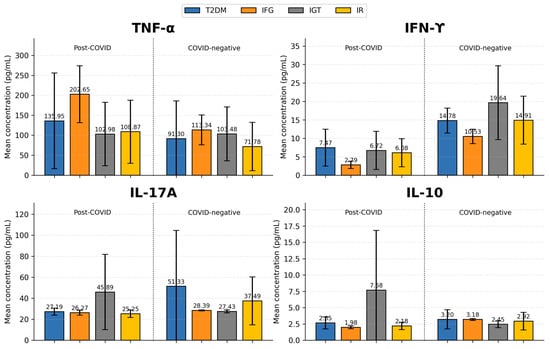- Article
Comparative Characteristics of the Immunometabolic Profile of Individuals with Newly Developed Metabolic Disorders and Classic Metabolic Syndrome
- Victoria Tsvetkova,
- Malvina Todorova and
- Milena Atanasova
- + 2 authors
Introduction: Immune dysfunction plays a significant role in Metabolic syndrome, contributing to both insulin resistance and chronic low-grade inflammation. This immune dysfunction is characterized by overproduction of inflammatory cytokines among which of primary importance are tumor necrosis factor-alpha (TNF-α), interleukin-6 (IL-6) and (MCP-1), whereas others such as interferon gamma (IFN-γ), IL-17A, and the anti-inflammatory IL-10 appear to be of secondary importance. Cytokines also play a significant role in Post-COVID disorders contributing to prolonged immune dysregulation and persistent subclinical inflammation. However, their role in the newly emerging metabolic disorders following infection remains poorly defined. Methods and materials: In the current study 78 patients (26 men and 52 women) were included, divided into two groups—group 1 (individuals with newly diagnosed carbohydrate disorders after proven COVID-19 or Post-COVID group; n = 35) and group 2 (COVID-19 negative persons with Metabolic Syndrome; n = 33). They were further divided into several subgroups according to type of metabolic disorder present. Standard biochemical, hormonal and immunological parameters were measured using ELISA and ECLIA methods, as well as some indices for assessment of insulin resistance were calculated using the corresponding formula. Results: Patients from both groups demonstrate similar metabolic parameters including BMI and unadjusted lipid and uric acid levels (p > 0.05). After adjustment for age, sex, and BMI revealed significant differences, Post-COVID status independently predicted higher fasting glucose, HbA1c, total cholesterol, LDL-cholesterol, triglycerides, uric acid, and insulin-resistance indices, indicating substantially impaired glycemic and metabolic control beyond traditional risk factors. Furthermore, the Post-COVID cohort demonstrated marked cytokine dysregulation, with significantly elevated levels of TNF-α, IFN-γ, IL-17A, and IL-10 after adjustment. Conclusions: The observed changes in both metabolic and immune parameters studied among the two groups show many similarities, but some significant differences have also been identified. Together, these findings indicate that Post-COVID metabolic dysfunction is characterized by inflammation-driven dyslipidemia, heightened oxidative stress, and persistent immune activation, distinguishing it from classical Metabolic syndrome.
22 December 2025


